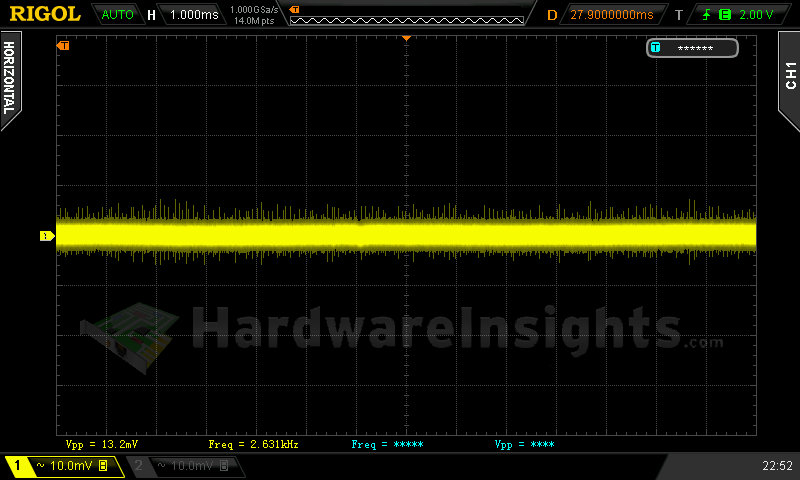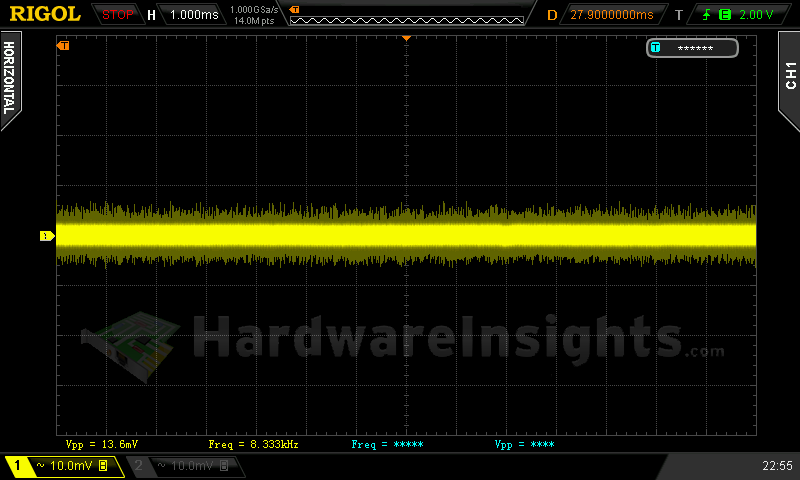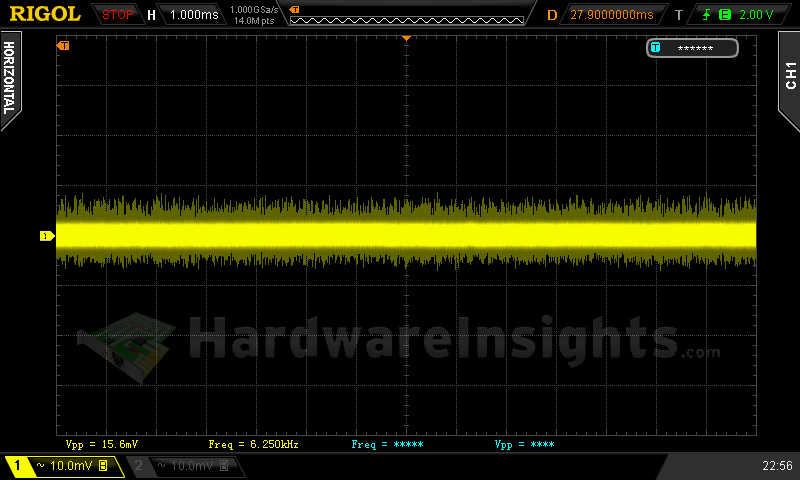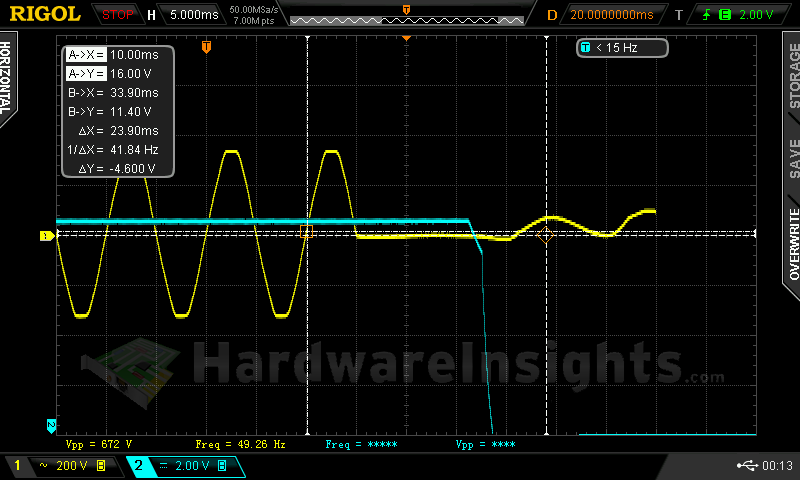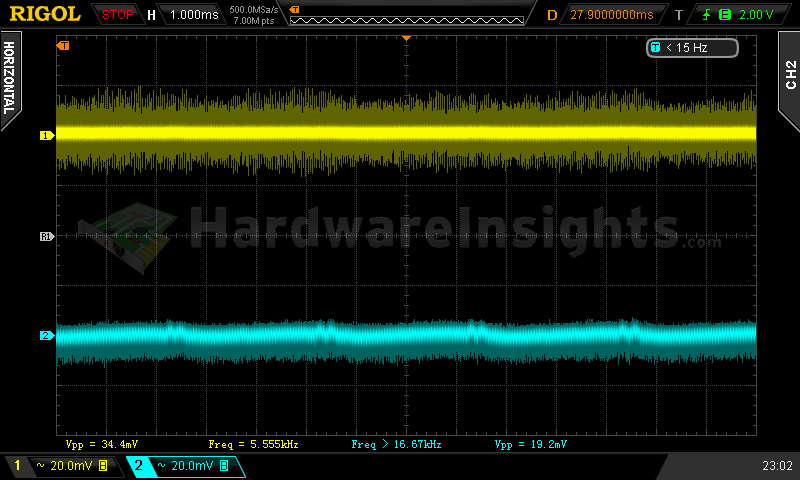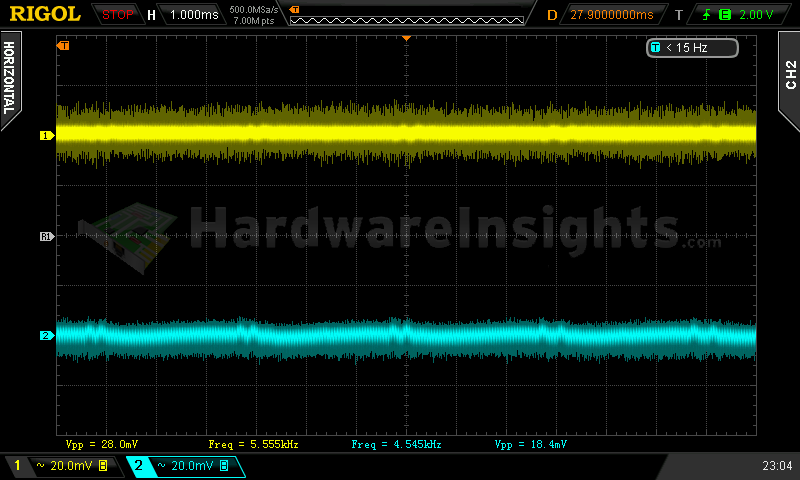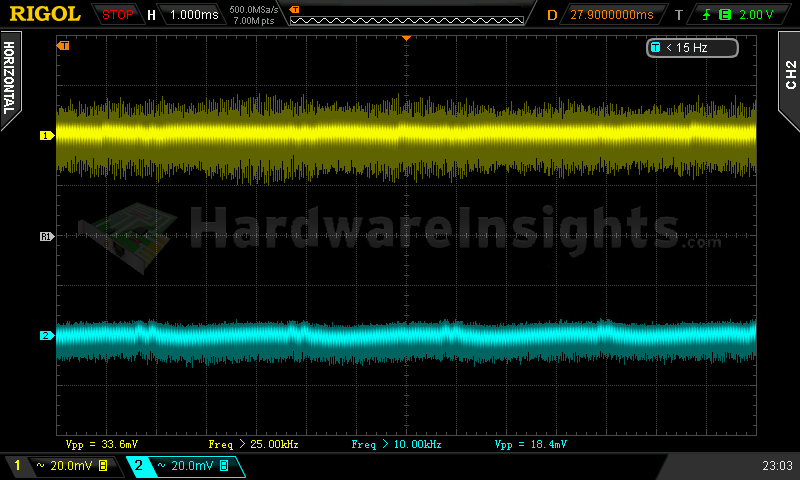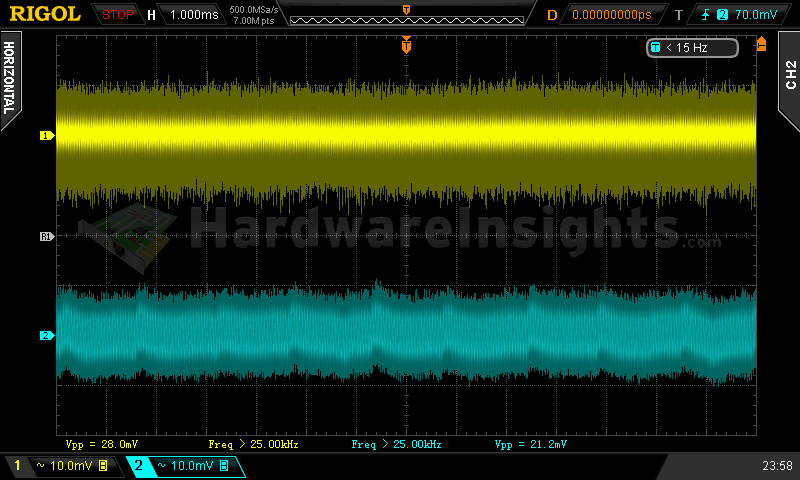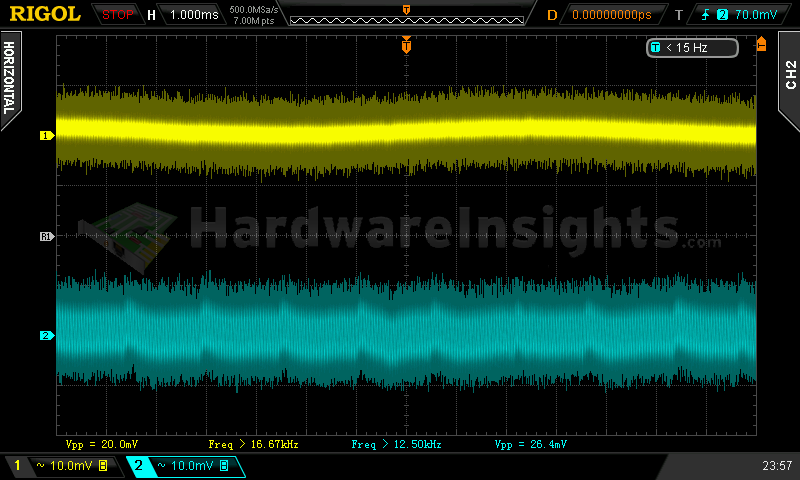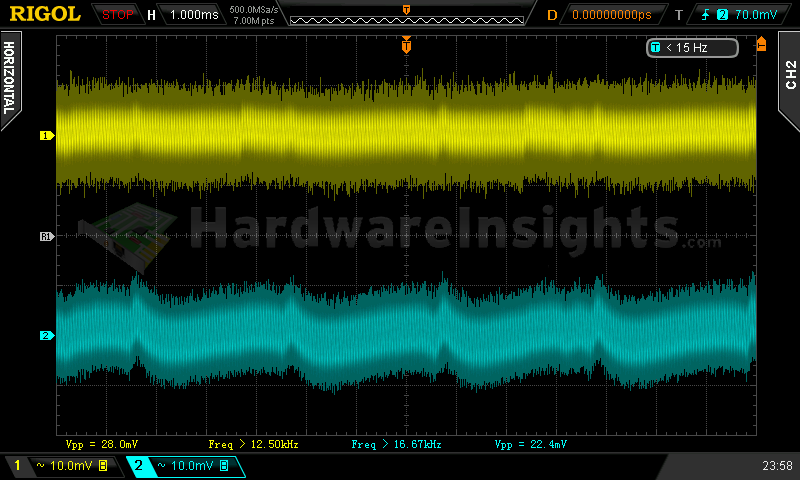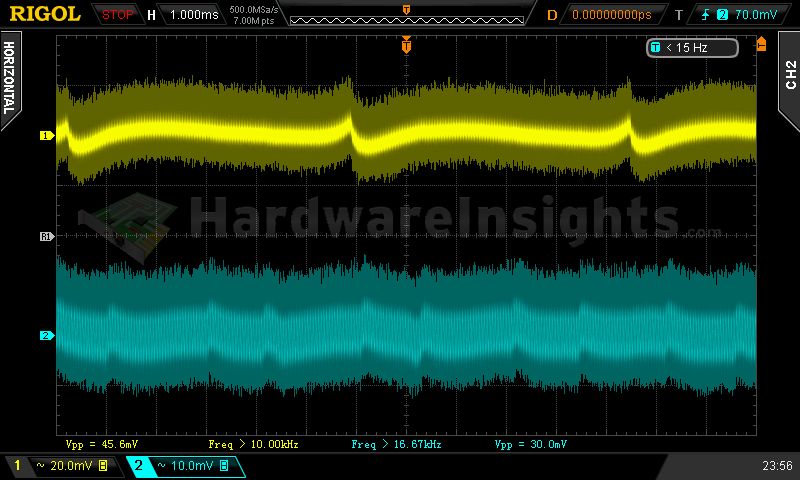Contents
- 1Introduction
- 1.1Packaging and accessories
- 2Connectors & cabling
- 2.1Casing & cooling
- 3Input filtering
- 4Primary side
- 4.1+5 V stand-by rail
- 5Secondary side
- 5.1Build quality
- 6Load testing
- 6.1Loading +5 V SB
- 6.2Voltage hold-up time
- 6.3Combined loading
- 6.4Combined loading ripple
- 6.5Crossloading, overloading
- 6.6Crossloading, overloading ripple
- 7Conclusion and evaluation
- 7.1Thanks
- 7.2Discussion
Load testing
Loading +5 V SB
As always, all load testing is done in accordance with our testing methodology. The voltage regulation is not bad, though the voltage may have been slightly higher (about 5.03 V), but the change is really small, just one percent. On the other hand ripple suppression is below average. In spec, yes, but over 10 mV is nothing special. Efficiency is on the higher side, around 76 %, that is nice value.
| Output (W) | Load (A) | Voltage (V)/ ripple (mV) | Input (W) | Efficiency/power factor |
| 0 | 0 | 5.00/13.2 | 0.5 | —/1 |
| 14.09 | 2.85 | 4.95/13.6 | 18.5 | 76.2 %/0.49 |
| 16.40 | 3.31 | 4.95/15.6 | 21.5 | 76.3 %/0.49 |
+5 V SB ripple (left to right): 0 A; 2.85 A; 3.31 A
Voltage hold-up time
The hold-up time of the +12 V rail on the scope image is good for 600 W unit, almost 24 ms. This was repeatedly the same value, however, I have not been able to test exactly this long interruption as my device went bad. Fortunately I have been at least able to get this reading.
Combined loading
Combined loading of the Silverstone Strider Essential Gold 600 W was mostly good. The efficiency with low loads is poor and climbs to 90% level quite slowly, at over 100 W it is still not even 85 %. Peak efficiency is over 92 %. Temperature was reasonable and did not cross 40 °C while the fan was spinning quite slowly (optically).
| Output power | Load/ voltage +5 V SB | Load/ voltage +3.3 V | Load/ voltage +5 V | Load/ voltage +12 V | Load/ voltage −12 V | Input power | Efficiency/power factor | Temperature intake/ outtake |
| 4.8 %/ 28.55 W | 0 A/ 4.99 V | 0.014 A/ 3.25 V | 0.327 A/ 5.04 V | 1.926 A/ 12.17 V | 0.298/ −11.47 V | 36.0 W | 79.3 %/ 0.69 | 24 °C/ 26 °C |
| 20 %/ 112.54 W | 0.48 A/ 4.98 V | 2.85 A/ 3.24 V | 2.241 A/ 5.04 V | 7.74 A/ 12.13 V | 0.294/ −11.50 V | 133.5 W | 84.3 %/ 0.96 | 24 °C/ 27 °C |
| 40 %/ 243.68 W | 0.96 A/ 4.96 V | 4.19 A/ 3.23 V | 3.40 A/ 5.04 V | 16.97 A/ 12.07 V | 0.298 A/ −11.54 V | 263.0 W | 92.7 %/ 0.99 | 24 °C/ 29 °C |
| 60 %/ 365.25 W | 1.89 A/ 4.93 V | 5.46 A/ 3.22 V | 4.90 A/ 5.06 V | 25.8 A/ 12.02 V | 0.298 A/ −11.59 V | 396.5 W | 92.1 %/ 1 | 24 °C/ 31 °C |
|
80 %/ 475.66 W |
2.33 A/ 4.91 V | 6.92 A/ 3.21 V | 6.78 A/ 5.07 V | 33.8 A/ 11.96 V | 0.293 A/ −11.61 V | 521.0 W | 91.3 %/ 1 | 24 °C/ 32 °C |
| 100 %/ 596.79 W | 2.79 A/ 4.91 V | 7.78 A/ 3.20 V | 7.94 A/ 5.06 V | 42.7 A/ 11.90 V | 0.300 A/ −11.67 V | 657.5 W | 90.8 %/ 1 | 24 °C/ 37 °C |
The voltage regulation was not as good however, this is design problem of all Aurum-based units. This time even the +3.3 V voltage started at just 3.25 and decreased with load, its regulation failed to meet even ±3% level while my requirements for high-end are ±2 %. The +12 V rail ended under nominal while the −12 V rail never even achieved nominal voltage.
Combined loading ripple
The ripple suppression of Silverstone Strider Essential Gold 600 W good in average, though on a few occasions it gets worse. Interesting thing consistent with other Aurum units is that the ripple starts high, than slightly decreases with load and often increases again under full load. The worst here was stand-by at 34.4 mV or 68.8 % of the allowed range. The +12 V ripple on the other hand is quite nice, it never crossed 1/4 of the 120mV range.
| Output % | Ripple +5 V SB | Ripple +3.3 V | Ripple +5 V | Ripple +12 V | Ripple −12 V |
| 4.8 | 34.4 mV | 28.0 mV | 33.6 mV | 19.2 mV | 57.6 mV |
| 20 | 26.8 mV | 19.2 mV | 23.2 mV | 20.0 mV | 34.4 mV |
| 40 | 24.4 mV | 18.8 mV | 25.6 mV | 18.4 mV | 36.8 mV |
| 60 | 27.2 mV | 18.0 mV | 20.4 mV | 19.6 mV | 36.0 mV |
| 80 | 21.6 mV | 16.4 mV | 20.8 mV | 22.8 mV | 35.6 mV |
| 100 | 28.0 mV | 20.0 mV | 28.0 mV | 30.0 mV | 45.6 mV |
Eh, seems that I forgot to save the −12 V ripple screenshot…
Ripple 4.8% load (left to right): +5 V SB; +3.3 V; +5 V. The second channel is connected to +12 V.
Ripple 100% load (left to right): +5 V SB; +3.3 V; +5 V; −12 V. The second channel is connected to +12 V.
Crossloading, overloading
Crossloading uncovered the worst of group design. With +5 V crossload, the +12 V voltage went way up, all the way from the allowable limit. Only with minimum specified load applied (from units manual) the voltage dropped barely in spec. With +12 V crossload, +5 V rose but not that badly as usual. Still the same bad Aurum…OCP on any rail was not triggered, this unit has no OTP so I did not risk it. Wearing sweater it worked fine for 15 minutes but the unit was already smelling quite badly and the fan did not seem to spin any faster – I have strong suspicion that as this platform has no sensing thermistor, the fan speed is set to static speed!
| Output power | Load/ voltage +5 V SB | Load/ voltage +3.3 V | Load/ voltage +5 V | Load/ voltage +12 V | Load/ voltage −12 V | Input power | Efficiency/power factor | Temperature intake/ outtake |
| 37 %/ 223.16 W | 0.487 A/ 4.94 V | 1.456 A/ 3.22 V | 23.60 A/ 4.77 V | 7.99 A/ 12.53 V | 0.282 A/ −11.98 V | 249.0W | 89.6 %/ 0.99 | 26 °C/ 30 °C |
| 22 %/ 130.14 | 0.478 A/ 4.95 V | 23.30 A/ 3.20 V | 1.498 A/ 4.91 V | 3.40 A/ 12.38 V | 0.288 A/ −11.80 V | 153.5 W | 84.8 %/ 0.97 | 27 °C/ 31 °C |
| 92 %/ 553.78 W | 0.476 A/ 4.93 V | 1.478 A/ 3.20 V | 1.563 A/ 5.16 V | 45.9 A/ 11.66 V | 0.300 A/ −11.47 V | 612.0 W | 90.5 %/ 1 | 26 °C/ 36 °C |
| 100 %/ 600.89 W | 3.22 A/ 4.86 V | 11.71 A/ 3.16 V | 8.59 A/ 4.57 V | 47.1 A/ 10.75 V | 0.248 A/ −10.67 V | 673.0 W | 89.3 %/ 1 | 30 °C/ 43 °C |
So under overload it was already over 43 °C. But that is still OK compared to voltage regulation. As usual voltages tanked so I only got about 650 W peak from the unit. Then the actual power started falling too. So no OPP and no UVP as usual (waking up around 10.5 V is not working protection for me). This platform is really obsolete these days, even cheap CWT platforms can handle OTP, OPP and OCP so their UVP does not even need to ever kick in.
Crossloading, overloading ripple
It is basically the same story as combined loading, though the +5 V SB ripple is even worse at 75.2 % of the allowed range.
| Output % | Ripple +5 V SB | Ripple +3.3 V | Ripple +5 V | Ripple +12 V | Ripple −12 V |
| 37 | 32.0 mV | 21.6 mV | 32.0 mV | 20.8 mV | 29.6 mV |
| 22 | 37.6 mV | 25.6 mV | 34.4 mV | 30.4 mV | 48.0 mV |
| 92 | 28.8 mV | 33.6 mV | 35.2 mV | 45.6 mV | 47.2 mV |
| 100 | 40.8 mV | — | — | 44.0 mV | — |
